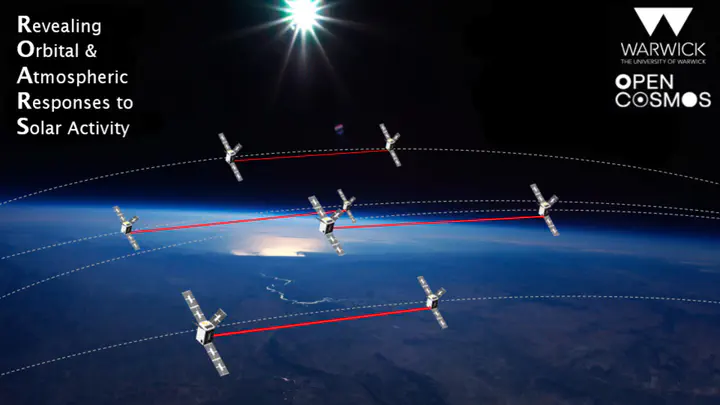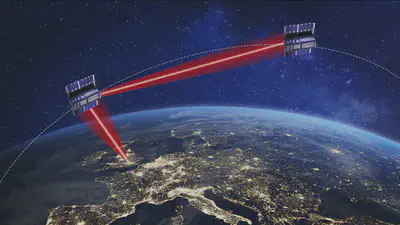ROARS (Revealing Orbital and Atmospheric Responses to Solar activity) WP3

PI: Prof. Eamon Scullion, Co-I: Dr. Richard Binns, Dr. Xuewu Dai, European Space Agency, 2023-2024, Workpackage 3:
Space weather and debris pose a huge problem for global communication systems and space exploration efforts. In February 2022, 40 Starlink satellites were lost, due to the effects of successive solar storms which caused a large atmospheric expansion and increased atmospheric drag, ultimately causing the satellites to burn up in the upper atmosphere. The ‘Revealing the Orbital and Atmospheric Responses to Solar activity’ (ROARS) project, led by the University of Warwick, aims to tackle the problem with a “swarm” of satellites. Funded by the European Space Agency, the ROARS mission concept involves eight satellites spread across Low Earth Orbit (LEO) that measure atmospheric variability, the drivers behind this, and the effects on satellite orbits.

In line with the Northumbria University’s plan for a £50M research centre (Northeast Space Skills and Technology, NESST ) sponsored by UK Space Agency, Lockheed Martin, etc., and as part of the ROARS mission, the Northumbria research team led by Professor Eamon Scullion, Dr. Richard Binns and Dr. Xuewu Dai, focus on using the laser to precisely measure how the distance between two Cubesat changes. Speaking about ROARS, Eamon said: “The Northumbria laser communications instrument forms a critical part of the payload of ROARS, enabling unique space science measurements, through coordinating the relative positions of the satellites in its laser ranging camp ability, with millimetre precision. This is a great example of the many different functionalities of this technology, and we’re excited about its future potential.”

Based on Northunmbria's previous work on [inter-satellite laser communications system, with £650k funded by UK Space Agency](https://www.northumbria.ac.uk/about-us/news-events/news/space-agency-laser-satellite/), the ROARS team at Northumbria University investigates the reuse of the existing laser communication link in CubeSats for precise timing and ranging, thus to provide a innovative solution to the space weather monitoring without additional hardware, weights and space. Dr. Xuewu Dai said: “ROARS is an exciting project that develops the swarm of next-generation CubSat swarm for space weather monitoring. The novelty of reusing laser communicaiton links to provide a common timing between two Cubstas and then measure the inter-Cubesat distances, fused with multiple coincident measurements from other sensors and navigation sources, will lead to improved awareness of space weather variations. Our Northumbria team has unique blend expertise of space physcial science, laser communication and time sycnhronisation technologies will bring new ideas and solutions to support the ROARS mission for success.”
Join us: a full PhD scholarship opportunity
We are lookng for talent PhD stduents and PostDocs to join our emerging space engineeering scheme. We offer full PhD scholarship, covering tuition fees (at the home student rate) and an impressive stipend of £18,622 per year. If you want to unlock an incredible opportunity to exploring space sciences and CubeSat swarms, embracing your passion for innovation and discovery, please contact us.
- Full PhD Scholarship www.findphd.com (Ref: IDRT24/EE/SPACE/DAI)
- Contact us Click here
- Email: Dr. Xuewu Dai (mailto: xuewu.dai@northumbria.ac.uk)
Announcement of £50m NESST space skills centre at Northumbria University from Northumbria University on Vimeo.
Background: Satellite Laser Communications
NASA sends cat video over 19 million miles using laser
On 19 Dec 2023, NASA declared the successful transmission of a 15-second-long high-definition cat video over 19 million miles (over 30 million km) from the he Psyche spacecraft to the Hale Telescope at Caltech's Palomar Observatory in San Diego County, California. The video was transmitted by using an encoded near-infrared laser and tt took 101 seconds for the laser to reach Earth. The maximum bit rate of 267 Mbps, faster than the speed of most home/office broadband to the Internet.
This is a “historic milestone.”, as the spacecraft Psyche continues its journey towards the asteroid belt between Mars and Jupiter, it will send high-data-rate signals back to Earth. Read more at NASA sends cat video over 19 million miles using laser